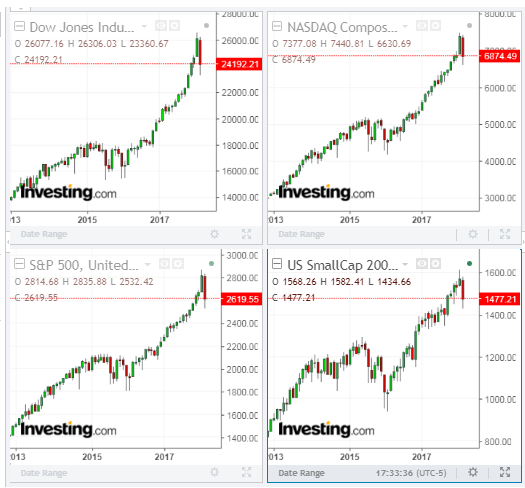by Diane Freeman
This is the first post of what we intend to become a bi-weekly round table series. Every other week we'll ask a selection of our contributors for their opinion on what we believe is the most pressing market-focused question of the week. This week we asked:
Now that volatility is back, do you think it's here to stay? And if so, what's the optimal strategy to maximize returns and mitigate risks?
Al Brooks
The volatility index has drifted up over the past 2 weeks while the Emini keeps making new highs. This increase in volatility might be a warning that the Emini will soon begin to have 2 – 5 % pullbacks within a month or two. Furthermore, it increases the chance of a 2 – 3 day 100 point selloff.
The week before, I wrote an article for Investing.com and my BrooksTradingCourse.com website entitled, “Emini forming blow-off top leading to giving back 2018 gains.”
What was my concern? The stock market has never been this overbought in the 122 year history of the Dow Jones Industrial Average and the 96 year history of the S&P 500 Stock Index. I used the lack of volatility as the measure of how unusually overbought the market was. For example, every low on the monthly Emini chart was above the low of the prior month for 15 months. The weekly chart had not touched its 20 week EMA in 65 weeks. Finally, the daily chart did not have a 5% pullback in over 400 trading days.
None of this ever happened in the history of the stock market and therefore this lack of variation (volatility) was an extreme buy climax. Stock market charts map out rational human behavior. Consequently, charts are genetically based, and patterns repeat. If something happens that is far beyond what has happened previously, it is unsustainable and therefore climactic. The streaks I just mentioned were therefore climactic. When something is as exceptionally extreme as these streaks were, the mean is far away. Regression to the mean requires a big move. It happened very quickly in this case.
This correction is due to the buy climaxes. It is therefore technically based. The 1st pullback in a bull micro channel typically lasts 1 – 3 months. Since the micro channel was on the monthly chart, the selloff should end soon.
It would take more than a year to duplicate the streaks that I discussed. As a result, this year has to be more volatile than last year. The answer to your question about whether volatility is here to stay is, “yes,” at least compared to last year. This year will be more normal.
The best market strategy? Traders should be looking to buy now that the Emini is down 10%. It might fall 20%, but that is not likely. The Emini will probably be at a new high in 4 – 6 months.
Suppose I am wrong, and the selloff is fundamentally based. Then the selloff could last 1 – 2 years, and the Emini could fall 20 – 50%. However, there is only a 20% chance that the 1st reversal from a bull micro channel will become a bear trend. Remember, the monthly chart had been in a micro channel for 16 months. I like the odds for the bulls.
Michael Ashton
The question is a bit of a red herring. One cannot both maximize return and mitigate risks. The mandate is to maximize returns subject to a level of risk that is acceptable to the investor. That amount of risk should be defined based on ordinary volatility, but also with reference to extreme events. If a market move such as we have had causes you to deviate from your plan, then you hadn’t correctly assessed the level of risk you were willing to take.
All such combinations of risk and return right now are worse than they were in 2010. Indeed, given where markets are (still) valued, some levels of desired return are unattainable at any risk. But, again, we don’t choose the return target we want and then calculate the risk; we start with the risk budget and then maximize our returns. Currently we find TIPS to be superior to nominal Treasuries at the low end of the risk/return spectrum and commodity indices to be superior to equities at the higher end. Moreover, both TIPS and commodities give some protection against inflation risk, which is typically the biggest non-hedged risk in a stock/bond portfolio. This is still not an attractive portfolio in terms of expected return, but it is a much better combination of expected return and risk.
Candy Matheson
I'm always loathe to suggest any specific hedging strategies in any market environment, inasmuch as it's really up to each investor and their portfolio manager to decide what's suitable. I would, however, mention that it really depends on one's own plan, and timeframes structured around that plan, as to what someone may be comfortable in deploying as a strategy. As a general rule of thumb, I'd suggest that traders/investors develop their plan ahead of time based on their risk tolerance levels and trade accordingly, but monitor external factors and influences on a short, medium and long-term basis to see if any adjustments to their plan need to be made to fit in with their own life circumstances, which are also subject to change at any time.
As I said yesterday:
Finally, we may very well see US equity markets spike to new highs in a "slingshot" manner, as portfolio managers look to post a monthly gain for February by month-end...but, I'm not laying any odds on that happening. You can see from the monthly chartgrid below of the Dow Jones 30, S&P 500, NASDAQ Composite, and Russell 2000 Indices that there will be a lot of ground to make up between now and then.
So, I'd keep an eye on the "volatility gauges" mentioned above for clues on equity direction, as part of your trading plan in the short term. Precisely what impact they may have on equities is difficult to pinpoint in this period of extreme volatility...but, they may be useful tools to add to your collection, nonetheless.
In other words, do your own due diligence and safeguard your trades/investments with your own risk-tolerance stop losses and/or hedges.
Andrew Thrasher
Volatility has been a long-time focus of mine, having won the Charles H. Dow award for my paper titled Forecasting a Volatility Tsunami. The spike in VIX that we've seen over the last week is truly historic and one that will go down in the history books.
As far as its impact on strategy, it's simply part of the market and is nothing new. While not necessary to the degree we saw on Feb. 5th, spikes in the VIX are common and have occurred numerous times in the current bull market. When volatility rises, it's important to stay focused on your own investment process and manage your risk exposure with as little emotion as possible.
Having pre-defined exit points for positions helps control any downside risk, allow you to pull the trigger on a trade to exit a position when it begins moving against you. Is volatility here to stay? I'd argue it never left, while the U.S. markets took a volatility vacation in 2017, it never truly disappeared, so yes volatility is here to stay and will always be part of the market environment in varying doses.
Editor's Note: We welcome reader suggestions for future questions. If you've got something market-focused you think is key, let us know in the comments. We can't guarantee every question will be used, but each good one will be considered.

